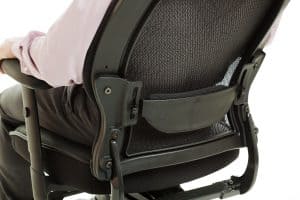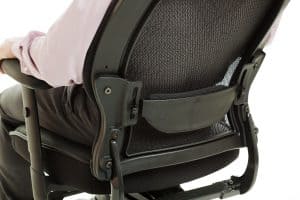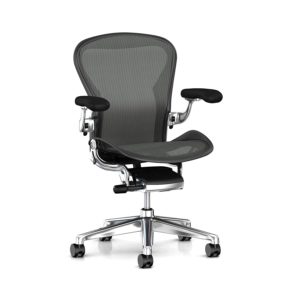If you’ve been reading our past two articles on lumbar support, “What Is Lumbar Support?” and “How Lumbar Support Works,” you understand the importance of having a chair that supports the natural curve of the spine. If not, check them out to see why office chairs have lumbar support.
Nevertheless, knowing the importance of lumbar support and actually feeling the benefits in practice are two different things. So different, in fact, that a lot of people experience the opposite – lumbar support makes their back hurt. In this article, we’ll try to explain why that happens and hopefully provide a solution.

The Function of Lumbar Support
When we sit in an ‘upright’ position, we distort the natural alignment of our spine. More specifically, sitting tends to flatten (decrease) the lumbar curve – the inward curve of the lower back. If we do this every once in a while, it is no big deal. Still, prolonged sitting creates a lot of pressure on lower back vertebrae, which can lead to compression of the disks, bones rubbing on each other, and pinched nerves, among other painful conditions.
However, we can’t avoid sitting, especially if our work demands it. Therefore, the only thing left to do is try and correct how we sit. In other words, we must sit with a good posture with all four spinal curves (not flattened nor accented) – including the lumbar curve. Unfortunately, this would be impossible without support because it would mean that people would have to flex their muscles for eight hours.
The solution is passively maintaining the spine’s natural alignment while the body is relaxed. That’s the main reasoning behind lumbar support – furniture that supports the spine’s natural curves.
To sum up, lumbar support refers to a furniture design or external furniture pieces that can prevent the flattening of the lumbar spine. But, if the flattening of the lumbar spine is bad, then why do some people feel pain or discomfort when using lumbar support?
Can Lumbar Support Be Harmful?
Lumbar support is marketed as the ultimate guarantee against back pain. This confuses people and makes them believe that discomfort, muscle soreness, or even pain are normal – as long as you use lumbar support, you’re safe.
That’s not true; lumbar support can be harmful in specific circumstances. However, it’s also true that sometimes, especially in the beginning, the soreness or discomfort may be normal. So, to better understand why lumbar support hurts your back and how to remedy the situation, let’s break down the reasons behind this conundrum.
Why Does Lumbar Support Hurt?
There are several reasons why you might experience pain or soreness after using a chair with lumbar supper. These include:
- Bad posture while sitting;
- (un)suitability of lumbar support design/piece;
- wrong position of the lumbar support;
- normal discomfort due to sore muscles;
Bad Posture While Sitting
Having lumbar support does not guarantee a good posture. Many people will still slip into their habituated way of sitting regardless of whether there’s lumbar support. And, when that way of sitting is really bad for the back, lumbar support might make things worse. Depending on how you sit, you might be pressing higher on your back or on one side more than the other.
Therefore, ensure your posture is good when sitting in a chair with lumbar support. Here are a few tips on how to sit in an ergonomic office chair.
- Make sure the height of the chair is suitable for your height. Your feet should be flat on the ground when the knees are at a 90° angle. If the chair doesn’t go low enough – use a footrest.
- Do not cross your legs as this creates uneven pressure on your spine, especially when sitting for long periods of time. With crossed legs, the lumbar support might be pressing more on one side than the other.
- If the seat adjusts horizontally, make sure that your lower back is touching the backrest – not pressing too firmly, but also not sitting away from it.
- Your arms should be at a 90° angle with your elbows resting on the armrest and your hands on the keyboard.
- Many chairs come with adjustable neck support. Make sure the head rests comfortably on the neck support, and it’s not pushed forward, as this creates upper back and neck pain.
- Keep your shoulders back and back straight – do not arch forward rounding the back. Do not slouch.
- Take short rests to stretch and move the body – every hour or two.
- Keep your body weight on the backrest – do not put your weight forward.
(Un)suitability of Lumbar Support Design/Piece
Unsuitable lumbar support design or external pieces can also hurt your back. To make this clearer, let’s briefly describe the types of lumbar support.
Types of Lumbar Support
Lumbar support comes in many forms. We can identify four main types: dynamic lumbar support, adjustable lumbar support, fixed lumbar support, and external lumbar support or lumbar pillow.
Fixed lumbar support is built into the chair’s design and cannot be moved. Adjustable lumbar support is built into the chair’s design, but depth, firmness, and height can be adjusted. Dynamic lumbar support adjusts on its own to your body shape. And finally, external lumbar support or lumbar pillow is an external piece you can attach to the chair to your liking.
Fixed lumbar support is most rigid, and it’s most likely to cause problems for people who are too tall, too short, too big, or too small for the chair. It’s important to have a lumbar support that fits your body shape, so before you invest serious money into an ergonomic office chair, try it out.
For instance, some people have a flatter lumbar curve than others whose curve is more intense. These people will need lumbar support with different depths.
To conclude: One size doesn’t fit everyone.
Wrong Position of the Lumbar Support
Sometimes, however, the lumbar support design might be fully adjustable and still hurt your back. The reason might be that you’re positioning it higher on your back than you need to. This will create discomfort and pain.
Fortunately, there’s a quick way to figure out where your lumbar support should be positioned. Sit on a chair with a straight back (not resting on the backrest) and run your hand through your back. In the lower back area, you’ll feel a slight inward curve that begins below the ribcage and ends slightly above the butt. This inward curve is your lumbar region. Check whether it is the same height as the lumbar support on your chair. If not, adjust it.
Tip: Consider the depth of the lumbar support, too. Some people will need deeper lumbar support than others.
Normal Discomfort Due to Sore Muscles
Finally, you might consider the possibility that your discomfort or pain is muscle pain – a reaction to your corrected posture.
It’s important to understand that bad posture is not a painful position; it just leads to painful consequences. Bad posture is something that your body is used to, and your muscles are weakened from it.
Therefore, correcting your posture and sitting upright might be painful in the beginning. Passive muscles will be activated and stretched, leading to soreness.
Allow some time to adjust to your new position, and be aware of how you sit. If your discomfort or pain persists after a couple of weeks, revisit our article and check some of the other recommendations.
How to Choose the Right Lumbar Support for Your Back?
To choose the right lumbar support for your back, you need to consider all the things we’ve mentioned throughout this article. You also need to be aware of your own needs, such as the depth of your spinal curvature, your height, size, and so on.
To make things easier, let’s quickly summarize all the considerations for making the best decision for your back.
- Make sure your chair has a lumbar support cushion with the right depth and size for you. Even better, invest in a chair that has a fully adjustable lumbar support or includes an external piece. This way, you’ll also be able to control the position of the lumbar support – another important factor.
- Budget for lumbar support: the best and fully adjustable office chairs with excellent ergonomics can be expensive. So, if you do not have the budget for an expensive office chair, get a lumbar pillow.
- How you use your chair is important. There is lumbar support for office chairs, gaming chairs, car seats, and more. Buy one that will fit your environment.
Conclusion
Lumbar support is one of the best inventions of the past century. It allows people to continue working hard on their desks without feeling intense lower back pain.
However, lumbar support should fit your lower back and should be positioned correctly to work. We explained how you could do that in this article and, hopefully, helped you use it more comfortably.




